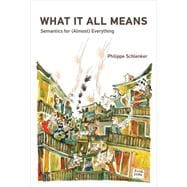How meaning works—from monkey calls to human language, from spoken language to sign language, from gestures to music—and how meaning is connected to truth.
We communicate through language, connecting what we mean to the words we say. But humans convey meaning in other ways as well, with facial expressions, hand gestures, and other methods. Animals, too, can get their meanings across without words. In What It All Means, linguist Philippe Schlenker explains how meaning works, from monkey calls to human language, from spoken language to sign language, from gestures to music. He shows that these extraordinarily diverse types of meaning can be studied and compared within a unified approach—one in which the notion of truth plays a central role.
“It’s just semantics” is often said dismissively. But Schlenker shows that semantics—the study of meaning—is an unsung success of modern linguistics, a way to investigate some of the deepest questions about human nature using tools from the empirical and formal sciences. Drawing on fifty years of research in formal semantics, Schlenker traces how meaning comes to life. After investigating meaning in primate communication, he explores how human meanings are built, using in some cases sign languages as a guide to the workings of our inner “logic machine.” Schlenker explores how these meanings can be enriched by iconicity in sign language and by gestures in spoken language, and then turns to more abstract forms of iconicity to understand the meaning of music. He concludes by examining paradoxes, which—being neither true nor false—test the very limits of meaning.








